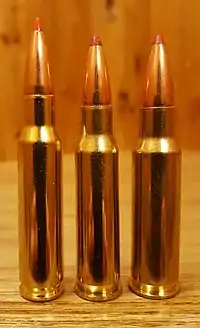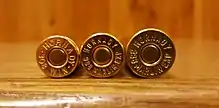.338 Marlin Express
The .338 Marlin Express is a cartridge developed by Marlin Firearms and Hornady. It is based on the .376 Steyr with a goal to duplicate the venerable .30-06 Springfield's performance in a cartridge compatible with lever-action firearms. The cartridge uses a slightly shorter, rimmed case to function in lever-action rifles with tubular magazines. As introduced in Hornady's LEVERevolution line of cartridges, it follows the design logic of the .308 Marlin Express which preceded it. The .338MX fires heavier .338 caliber bullets than the .308 Marlin Express at roughly the same velocity. It is chambered in Marlin's Model 338MX and 338MXLR rifles using the Marlin Model 336 action.[2]
| .338 Marlin Express | ||||||||
|---|---|---|---|---|---|---|---|---|
 .308 Winchester (left), with .308 Marlin Express (center), and .338 Marlin Express (right) | ||||||||
| Type | Rifle | |||||||
| Place of origin | USA | |||||||
| Production history | ||||||||
| Designer | Marlin / Hornady | |||||||
| Designed | 2009 | |||||||
| Manufacturer | Hornady | |||||||
| Produced | 2009–present | |||||||
| Specifications | ||||||||
| Parent case | .376 Steyr | |||||||
| Case type | Semi-rimmed, bottleneck | |||||||
| Bullet diameter | .338 in (8.6 mm) | |||||||
| Neck diameter | .372 in (9.4 mm) | |||||||
| Shoulder diameter | .496 in (12.6 mm) | |||||||
| Base diameter | .502 in (12.8 mm) | |||||||
| Rim diameter | .548 in (13.9 mm) | |||||||
| Rim thickness | .045 in (1.1 mm) | |||||||
| Case length | 1.886 in (47.9 mm) | |||||||
| Overall length | 2.583 in (65.6 mm) | |||||||
| Rifling twist | 1:12 in (300 mm) | |||||||
| Primer type | WLR | |||||||
| Ballistic performance | ||||||||
| ||||||||
| Test barrel length: 24 in (610 mm) Source(s): 338 Marlin Express LEVERevolution at Hornady web site & MidwayUSA and C.I.P. Data[1] | ||||||||
Design History and Cartridge Performance
Whereas the .308 Marlin Express began by modifying the .307 Winchester, Hornady and Marlin engineers started with a previous collaboration between Hornady and the Austrian arms maker Steyr, the .376 Steyr, when designing the .338 Marlin Express. The case of the .376 Steyr was given a thicker web for added strength, then necked down to .338. The .308 Marlin Express, on the other hand, was made with a thinner web than its parent case, the .307 Winchester, for additional capacity. Although the thicker case webbing reduced capacity, new powders allow the .338 Marlin Express to achieve velocities similar to the .338 Federal with significantly lower pressures. Hornady engineers then looked to the projectile for the new cartridge. They settled on the 200-grain .338 projectile from their .338 Winchester Magnum line. The existing bullet was remade with a thinner jacket in order to promote expansion and upset at longer ranges. This 200-grain .338" projectile is able to impart significantly more energy than the 160 gr projectile used in the .308 Marlin Express, despite similar muzzle velocities. Furthermore, the projectile's high ballistic coefficient allows the .338 Marlin Express to maintain velocity to greater distances than big bore lever cartridges such as .45-70, .444 Marlin, or even the high performance .450 Marlin. Although the heavy bullet weight of these cartridges allow them more muzzle energy, the ballistic advantage of the .338 Marlin Express's projectile begins to show beyond 100 yards. After that point the .338 Marlin Express's projectile retains more energy than even the .450 Marlin. Like the .308 Marlin Express, the .338 Marlin Express was designed to be a relatively flat shooting cartridge, taking advantage of the bullets Hornady designed for the rounds. Its trajectory is similar to the .30-06 Springfield.[3]
Comparison

The .338 Marlin Express was designed to produce performance similar to the .30-06 Springfield. This would give lever-action hunters improved performance over their .30-30 Winchester rounds. The table below shows how the rounds compare. Note that reloading data for 200-grain (13 g) bullets for some of the cartridges is not available. Extensive loading data for the .338 Marlin Express is not yet available. The powder used in the Hornady loading is also not yet commercially available as of Feb '09. This round was designed with an elastomer tip, so that the .338 projectile would be safe for use in the tubular magazines of lever-action rifles. Traditional spitzer bullets are not compatible with the tubular magazines. This is due to the danger of the hard, pointed bullet-tip igniting the primer of the round in front of it under recoil impulse. The softer tip eliminates the hazards of stacking pointed rounds end to end in a tubular magazine.
| Cartridge | Bullet Weight (gr) | Muzzle velocity(ft/s) | Muzzle energy(ft-lbf) | BC | Velocity (ft/s)/Energy (ft-lbf) @ 400yds |
|---|---|---|---|---|---|
| .338 Marlin Express | 200 | 2565 | 2922 | .430 | 1820/1471 |
| .308 Marlin Express | 160 | 2660 | 2513 [4] | ? | 1836/1197 |
| .30-30 Winchester | 160 | 2300 | 1880 [5] | ||
| .30-06 Springfield | 200 | 2542 | 2879 [6] | ||
| .30-06 Springfield | 200 | 2625 | 3061 [7] | ||
| .376 Steyr (Parent Cartridge) | 210 | 3011 | 4229 | ||
| Cartridge | Bullet Weight (gr) | Muzzle velocity(ft/s) | Muzzle energy(ft-lbf) | BC | Velocity (ft/s)/Energy (ft-lbf) @ 400yds |
|---|---|---|---|---|---|
| .307 Winchester | 150gr | 2693 | 2416 [8] | ||
| .300 Savage | 150gr FMJ | 2765 | 2547 [9] | ||
| .308 Winchester | 150gr FMJ | 2809 | 2629 [10] | ||
| .30-06 Springfield | 150gr FMJ | 2900 | 2820 | ||
| .308 Winchester | 180gr Nos AccuBond | 2550 | 2598 [11] | ||
| .30-06 Springfield | 200gr SP | 2542 | 2879 [6] | ||
| .30-06 Springfield | 200gr OPP | 2625 | 3061 [7] | ||
| .338 Federal | 210gr Nos Part | 2630 | 3226 | ||
| .325 WSM | 200gr Accubond CT | 2950 | 3866 | ||
| .338 Winchester Magnum | 200gr SP | 2950 | 3866 | ||
| .35 Remington | 200gr Lead Flat Nose | 2084 | 1929 | ||
| .348 Winchester | 200gr | 2530 | 2840 | ||
| .358 Winchester | 200gr SP | 2500 | 2776 | ||
| .35 Whelen | 200gr | 2798 | 3478 | ||
| .340 Weatherby Magnum | 200gr SP | 3221 | 4607 | ||
| 9.3x62mm Mauser | 231 gr Oryx | 2600 | 3550 | ||
See also
References
- C.I.P. 338 Marlin Express (online-PDF 39,6 KB)
- "308 Marlin Express at Marlin web site". Archived from the original on 2006-12-24. Retrieved 2009-02-21.
- "All Aboard the .338 Marlin Express" article in Peterson's Rifle Shooter Magazine
- "308 Marlin Express LEVERevolution at Hornady web site". Archived from the original on 2007-08-12. Retrieved 2009-02-21.
- the .30-30 Winchester by Chuck Hawks
- "MidwayUSA data for Lapua Ammunition .30-06 Springfield 200gr Soft Point ammunition". Archived from the original on 2009-10-07. Retrieved 2009-02-21.
- "MidwayUSA data for Norma Ammunition .30-06 Springfield 200gr "Oryx Protected Point" soft point ammunition". Archived from the original on 2009-10-07. Retrieved 2009-02-21.
- ".307 Winchester reload data by Accurate Powder" (PDF). Archived from the original (PDF) on 2007-09-28. Retrieved 2018-11-26.
- ".300 Savage reload data by Accurate Powder" (PDF). Archived from the original (PDF) on 2007-09-30. Retrieved 2009-02-21.
- ".308 Winchester reload data by Accurate" (PDF). Archived from the original (PDF) on 2007-09-28. Retrieved 2018-11-26.
- "MidwayUSA data on Black Hills Gold Ammunition .308 180gr Nosler Accubond load. This load uses a polymer tipped hunting round similar to that of Hornady's .338 Marlin Express". Archived from the original on 2009-04-17. Retrieved 2009-02-21.